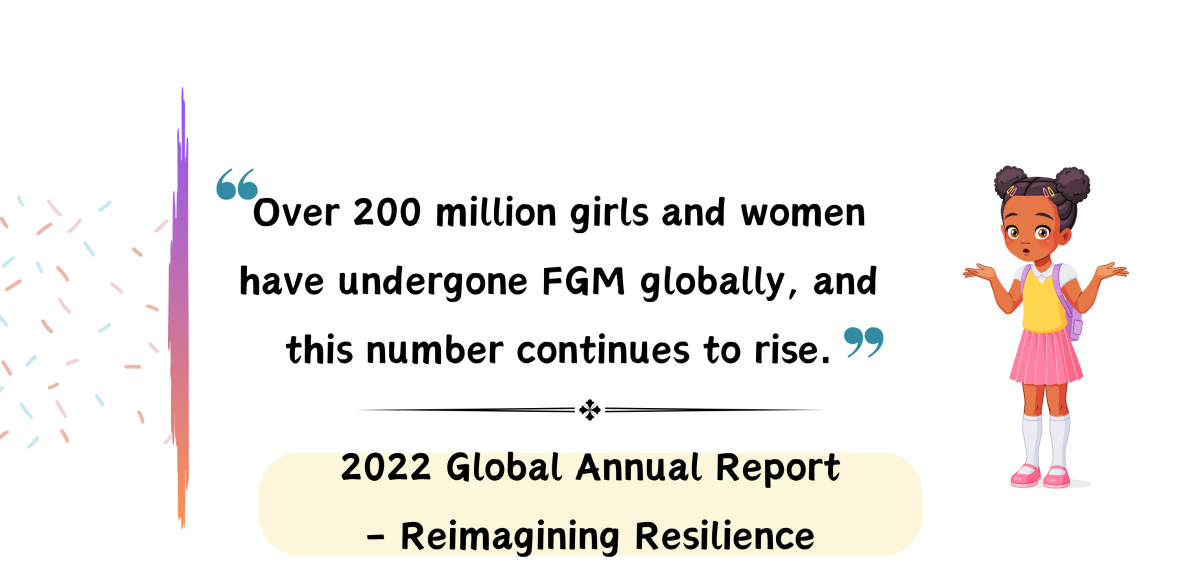
In a world marked by progress and development, there still exists a hidden crisis that is affecting millions of girls and women, especially children. Female Genital Mutilation (FGM).
Female Genital Mutilation (FGM) is a practice shrouded in tradition. Imagine a journey that takes you from ancient customs to the modern-day battleground for human rights. FGM is that journey, where culture clashes with compassion, and where the fight to protect women and girls’ well-being meets the challenge of breaking free from centuries-old chains.
This harmful practice not only violates girl’s rights but also hampers sustainable and just development. The numbers are shocking, with over 200 million girls and women worldwide having undergone FGM. The urgency to eliminate FGM is evident, but the road ahead is challenging.
In 2022, the UNFPA-UNICEF Joint Programme on the Elimination of FGM launched Phase IV, aiming to fulfill the global promise of ending FGM by 2030 amidst new and intensified challenges, what is often termed the “polycrisis.”
The Polycrisis: Unprecedented Challenges
The term “polycrisis” refers to the multiple, intersecting crises that disproportionately affect girls and women, especially those in the most vulnerable situations. These crises have increased the risks of FGM in many countries:
Economic Impact: The growing economic insecurity and inequalities stemming from conflict, climate change, and the COVID-19 pandemic among others have deepened poverty, making it more likely for girls to undergo FGM, especially to be married off.
Humanitarian Crises: Humanitarian response plans are often neglecting the needs of girls and women at risk of or affected by FGM during crises, making them more vulnerable. There is a need to integrate FGM prevention and response into these plans.
Heatwaves, droughts, floods,storms, hurricanes and wildfires are forcing families to have their daughters undergo FGM at younger ages to increase marriage prospects. Climate-related disruptions in services like school closures increases FGM risks.
Almost 90% of countries where FGM is prevalent are considered fragile contexts, with extreme fragility in places like Eritrea, Somalia, Sudan, and Yemen. More often than not, girls are more exposed to FGM in fragile situations, increasing the risks they face.
Everyone needs to remember that FGM is not just a cultural practice, but it carries profound physical, mental, and sexual and reproductive health consequences.
How does education intersect with female genital mutilation?
Well, The intersection of education and female genital mutilation (FGM) is a complex and crucial issue. FGM is deeply rooted in culture, while education can either empower change or perpetuate traditional norms.
Nonetheless, education plays an important role in addressing FGM, as Unicef’s data brief shows that girls and women with even basic education are more likely to oppose FGM. This likelihood increases to 70% if they have secondary education or higher. If a girl’s mother has primary education, the girl is 40% less likely to undergo FGM compared to those with uneducated mothers.
Importantly, in areas affected by crises, where 54% of girls are not in school, there’s a higher risk of FGM, which affects both current and future generations.
The World Health Organization estimates that the total financial cost of health care for girls and women living with conditions caused by FGM is a staggering US $1.4 billion annually. This burden falls heavily on some of the world’s poorest countries, further deepening inequalities.
That is not all, the fight against FGM faces a significant funding gap. To reach its goals in 31 countries where FGM is common by 2030, it needs $3.3 billion. But there’s only about $238 million available, mostly from official help, so there is an urgent need for private businesses and charities to give more money to fill this gap.
In the midst of the world’s complex problems, the UNFPA-UNICEF team is getting ready to reveal a toolkit with a name that’s a bit of a mouthful but full of promise: “Female Genital Mutilation and the Humanitarian Development Nexus: Practical Ways to Support Programme-Level Implementation.”
This toolkit is aiming at integrating FGM into emergency and humanitarian responses, this approach is a game changer especially to vulnerable communities, making sure that they have access to FGM preventions and responces services when they need it the most.
In 2023, the joint programme will be developing a comprehensive human rights education strategy. This strategy is designed to cultivate an informed and continuous demand for protection from FGM, driven by girls and women themselves. But it doesn’t stop there. It encourages community members, service providers, civil society organizations, and policymakers to champion the rights of girls and women to live free from FGM.
In the battle against FGM, education becomes the beacon of hope, a force for change, and the cornerstone of a more equitable, healthier, and just future for women and girls worldwide

Leave a Reply